Acadia Morgan
Introduction
Domestic violence (DV) is becoming one of the top health concerns in the United States. By understanding what DV is and what the signs of abuse are, people can take more action to prevent DV from happening to someone they love. Merriam-Webster defines DV as any violent or abusive behavior directed by one family or household member against another (Domestic violence, 2021). DV is a pattern of abusive behavior that is typically done to gain control over a victim. There are many types of abuse that are considered DV including physical abuse, sexual abuse, emotional abuse, economic abuse, psychological abuse, threats, and stalking (Mayo Clinic, 2020). Each of these types of abuse causes serious health problems that can greatly affect the health of victims.
The Victims
DV is a serious problem for people of all shapes, sizes, and ages. In the past, DV was referred to as “wife abuse”, and the definition of DV was confined to only abuse against wives. This definition has been changed to account for the fact that wives are not the only people who fall victim to DV. The current definition of DV victims includes all people regardless of socioeconomic background, education, race, age, sexual orientation, religion, or gender. DV is more common in certain groups of people. Females are more likely than males to be victims of domestic abuse, with about 29% of women experience this kind of abuse in their life (Baugher & Gazmararian, 2015), and about 1 in 10 men (CDC, 2020). American Indian/Alaskan Native women experience the highest rate of lifetime victimization. Asian/Pacific Islander women generally have a lower rate of domestic abuse. Homosexual males are also more likely than heterosexual males to experience abuse (Grossman & Lundy, 2007).
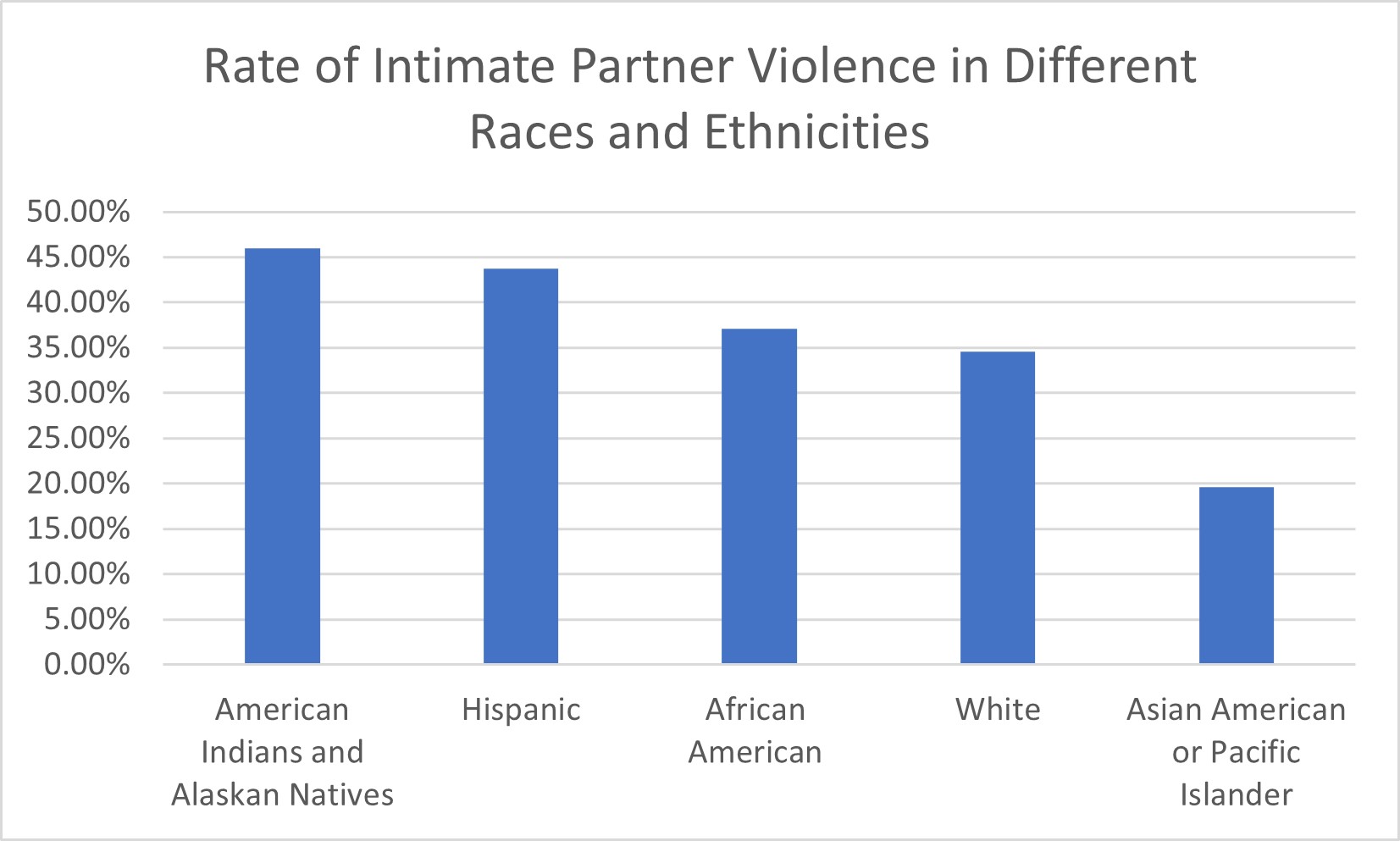
“Rate of Intimate Partner Violence in Different Races and Ethnicities” by Acadia Morgan is in the Public Domain and was created based on Urban.org.
There are many reasons why DV rates are different across different populations. One of the most important factors is socioeconomic status (SES). There is a correlation between poverty and race/ethnicity and people of color are less likely to be poor compared to white people. This means that SES is a better predictor than race/ethnicity because of the increase in differences between groups due to economic factors. Research has indicated that ethnic differences in rates of DV often decrease when social class, occupation, and employment status are taken into account (Grossman & Lundy, 2007).
Males as the Victim
Male victims of domestic violence often struggle with knowing or admitting they are being abused. The male stereotype of strength, power, and leadership hinders men from reporting violence for fear of being seen as weak or unfit. Interpersonal violence is severely overlooked in men. Nearly 1 in 4 men have experienced some form of sexual violence in their lifetime. 97% of men who experienced rape, physical violence, or stalking by an intimate partner had only female abusers (CDC, 2020). This shows that interpersonal violence is severely overlooked in men because the numbers of abuse towards men are startling. It is common for men who experience DV to not realize they are a victim. Male survivors of domestic violence often act out verbally or physically against their abusers during times of conflict. The abusers then use this outburst to make the victims think they are the ones at fault. To hear a man’s personal DV experience, please watch the following TED talk by Andrew Pain.
Andrew Pain – Domestic abuse: not a gender issue by TED is licensed under CC BY-NC-ND 4.0
There has been an increased awareness surrounding domestic violence against women from the Me Too Movement and other media movements, but these movements included a very small amount of focus on domestic abuse against men. The framing of domestic abuse as an issue faced by women and not men negatively influences men’s ability to understand and label their abuse (Wallace et al., 2019). Many people hear DV and immediately think women are the only victims, but that is so far from the truth. Men experience domestic abuse too, but men often do not seek help for this violence until the abuse has become extremely severe. Males are much less likely to report cases of domestic abuse for fear of the authorities not believing them or being seen as weak.

Health Effects of Domestic Violence
DV can negatively affect health in many different ways. Children exposed to domestic violence are more likely to experience developmental problems, psychological disorders, problems at school, aggressive behavior, and low self-esteem. The cycle of domestic abuse usually starts in childhood and can be carried on throughout a person’s lifetime. Research has found that domestic violence is linked to serious psychological disorders and excessive drinking (Mayo Clinic, 2020).
Many people who experience abuse face post-traumatic stress disorder (PTSD) as a result. PTSD is a very serious disease that can cause terrifying memories of the event, nightmares, flashbacks, or distress as a result of a trauma. PTSD in victims of domestic violence can cause problems in all aspects of their lives and relationships. Both men and women that are exposed to domestic violence have increased odds of attempting suicide. DV takes a huge toll on mental health which can also lead to substance abuse (Dufort et al., 2015).
DV also leads to an increase in injuries such as bruises, cuts, broken bones, lost teeth and hair, and other physical traumas. In women, DV also has a negative effect on reproductive health. DV increases the risk of sexually transmitted infections, vaginal bleeding, vaginal infections, pelvic pain, painful urination, urinary tract infection, painful sexual intercourse, miscarriage, unintended pregnancies, abortions, low birth weights, pre-term labor, and neonatal death (Kiss et al., 2012). The stress experienced by both men and women victims of DV can also cause an increased risk of cardiovascular disease, arthritis, asthma, chronic pain, diabetes, and digestive disorders (Pietrzak et al., 2012).
DV is a huge issue in the United States and the rest of the world. This issue is overlooked in men, and men are typically viewed as the perpetrator and not the victims. This stigma needs to be overcome in order for the world to make improvements in the prevention of domestic violence.
Cycle of Violence
DV victims often follow a circular pattern of abuse called the cycle of violence. Abuse in a relationship is often not random and typically follows a three phase cycle of a tension phase, a crisis phase, and a honeymoon phase. The tension phase is when the relationship between the victim and the abuser is becoming strained. The abuser begins to become argumentative, angry, criticizing, and testing. The abuser may use coercion, threats, or minor fights to subdue their victim. The tension gets worse and worse over time. This phase can go on for any amount of time. During this time of tension, the victim often begins to feel the looming sense that something bad will happen and they are walking on thin ice.
The tension phase goes into the crisis phase when the explosion of violence occurs. This can be any form of abuse such as physical, emotional, or sexual abuse. This is the phase when an injury occurs. During this phase the abuser often asserts their power in other ways by isolating the victim to hide their abuse, they keep the victim from seeking help or contacting the police, or restrain the victim to keep them subdued. This is the most dangerous phase that most characterizes as DV.
After the tension phase, the relationship transitions into the honeymoon phase. This is the time when the abuser seeks to apologize to the victim to try to mend the relationship and regain the victim’s love and trust. The abuser could promise it will never happen again, and say they will seek help. Justification is often used by the abuser to try to justify their actions to the victim, for example, the abuser could blame their behavior on drugs or alcohol. Love is built back up as the victim is showered with compassionate words, actions, and gifts. It is during this time that the victim feels as if things will get better, and they begin to feel love or trust for their abuser again. Unfortunately, this phase will not last, and it is only a matter of time before the relationship enters the tension phase as the cycle continues (Metropolitan Police Department, n.d.).
These phases tend to repeat themselves over time, whether it be over days, months, or even years. Sometimes the time between cycles gets shorter as abuse continues and the abuser gets more and more unstable. The longer a relationship lasts, the faster the cycles turn which makes it extremely important to seek help for abuse before the situation worsens. Love, fear, and hope can be the reasons why victims stay in an abusive relationship and continues in this deadly cycle.
Seeking Help
DV can happen to anyone, it is not just a problem for women. It can be difficult to identify if someone is in an abusive relationship. Men often struggle to see themselves as the victims which makes them less likely to seek help. DV can cause many negative physical and psychological health effects including low self-esteem, PTSD, bruising, fractures, reproductive issues, and many more. The cycle of violence can be extremely hard to stop. If the partner is physically aggressive, unpredictable in expressing emotions, controlling of time and money, verbally threatening, or isolating someone; they may be experiencing DV. If you or someone you love is experiencing DV, please reach out to the National Domestic Violence Hotline at 800.799.SAFE or visit their website https://www.thehotline.org/ for help and support.
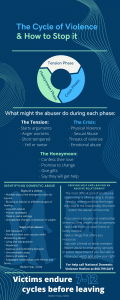
Chapter Review Questions
1. What rate/ethnicity experiences the highest rate of domestic violence?
A. Asian American/Pacific Islander
B. Hispanic
C. Caucasian
D. American Indian/Alaska Natives
2. What recent social movement has increased awareness surrounding domestic violence?
A. The Effective Altruism Movement
B. The Me Too Movement
C. The LGBTQ+ Movement
D. Criminal Justice Reform Movement
3. Children who are exposed to domestic violence are more likely to experience which of the following issues EXCEPT:
A. Developmental delays
B. Psychological disorders
C. Low self-esteem
D. Increased self-reliance
References
Baugher, A. R., & Gazmararian, J. A. (2015). Masculine gender role stress and violence: A literature review and future directions. Science Direct, 24, 107–112. https://psycnet.apa.org/record/2015-39380-009.
BetterHelp. (2020, April 15). 6 Ways To End The Cycle Of Abuse. Betterhelp. https://www.betterhelp.com/advice/abuse/6-ways-to-end-the-cycle-of-abuse/.
Centers for Disease Control and Prevention. (2020, June 1). Intimate partner violence, sexual violence, and stalking among men. https://www.cdc.gov/violenceprevention/datasources/nisvs/men-ipvsvandstalking.html#:~:text=Understanding%20Violence%20Against%20Men&text=Approximately%201%20in%2010%20men,form%20of%20IPV%2Drelated%20impact.
Desperate Stressed Man [Image PNG/AI]. (2017). Pixabay. https://pixabay.com/illustrations/desperate-stress-stressed-problem-2676556/
Dufort, M., Stenbacka, M., & Gumpert, C. H. (2015). Physical domestic violence exposure is highly associated with suicidal attempts in both women and men. European Journal of Public Health, 25(3), 413–418. https://doi.org/10.1093/eurpub/cku198.
Grossman, S. F., & Lundy, M. (2007). Domestic violence across race and ethnicity. Violence Against Women, 13(10), 1029–1052. https://doi.org/10.1177/1077801207306018
Kiss, L., Schraiber, L. B., Heise, L., Zimmerman, C., Gouveia, N., & Watt, C. (2012). Gender-based violence and socioeconomic inequalities: Does living in more deprived neighbourhoods increase women’s risk of intimate partner violence? Social Science and Medicine, 74(8), 1172–1179. https://www.sciencedirect.com/science/article/pii/S0277953612000494?casa_token=jq0fXEsEBD8AAAAA:fUay22ctW6s13mZd8gppuF4PQv0hhUUE7qQI6rGEHz4cJEZmZ01QhKQhZEVWLXPLvDZ2O9sI.
Mayo Foundation for Medical Education and Research. (2020, February 8). Domestic violence: It happens to men, too. Know the signs. Mayo Clinic. https://www.mayoclinic.org/healthy-lifestyle/adult-health/in-depth/domestic-violence-against-men/art-20045149.
Metropolitan Police Department. (n.d.). The Cycle of Violence. https://mpdc.dc.gov/page/cycle-violence.
Pain, A. (2019, November). Domestic abuse: not a gender issue. TED. https://www.ted.com/talks/andrew_pain_domestic_abuse_not_a_gender_issue?utm_campaign=tedspread&utm_medium=referral&utm_source=tedcomshare.
Pietrzak, R. H., Goldstein, R. B., Southwick, S. M., & Grant, B. F. (2012). Physical health conditions associated with posttraumatic stress disorder in U.S. older adults: results from wave 2 of the National Epidemiologic Survey on Alcohol and Related Conditions. Journal of the American Geriatrics Society, 60(2), 296–303. https://doi.org/10.1111/j.1532-5415.2011.03788.
Reach Out. (2021). Domestic violence and what you can do about it. Abuse and violence | ReachOut Australia. https://au.reachout.com/articles/domestic-violence-and-what-you-can-do-about-it.
Rate of intimate partner violence, by race and ethnicity [Infographic PNG]. (2010). Urban Wire. https://www.urban.org/urban-wire/what-we-know-about-intimate-partner-violence-asian-american-and-pacific-islander-communities.
Violence Prevention [Infographic PNG]. (2020). Center for Disease Control. https://www.cdc.gov/violenceprevention/intimatepartnerviolence/fastfact.html
Wallace, S., Wallace, C., Kenkre, J., Brayford, J., & Borja, S. (2019). Men who experience domestic abuse: a service perspective. Journal of Aggression, Conflict and Peace Research, 11, 127–137. https://www.emerald.com/insight/content/doi/10.1108/JACPR-03-20180353/full/pdf?casa_token=uMsi2sgJaLYAAAAA:gby6AiZKcSyfGZqnnQwl55zTOn7c9uGXD7eN9PNOPrYc8He3HC5PYuIVTB8vaNcJGJmoMtTSc1ZshmQ0NgGYMZujhTdMzFRJkZg_zjs3YAg7gvqdiQ.
Introduction
In males, there are a few different kinds of hormones. The main type that most everyone knows about is testosterone. However, males actually also have the female hormone, estrogen. The types of estrogen that men have are called estrone and estradiol (Jewell, 2019). Men also have the androgens DHEA and androstenedione (Gray et al., 2017). It is important for men to understand the roles of these hormones as they age.
Hormone Production
Testosterone is produced in a couple of different places in the body. The main place is the Leydig cells, found in the testes. The adrenal glands also produce a small amount of testosterone. Testosterone production is regulated by certain areas of the brain, the hypothalamus, and the pituitary gland. The hypothalamus releases a hormone called gonadotropin-releasing hormone, which makes the pituitary gland produce and release another hormone called luteinizing hormone (LH). Once LH enters the bloodstream, it travels to the testes and starts the production of testosterone (Society for Endocrinology, 2018). Estrogen is also produced in different places in the male body. The testes produce around 20% of a male’s total estrogen, while the rest actually comes from the conversion of testosterone in areas of the body such as fat tissue, bones, the skin, and the brain (Cooke et al., 2017).
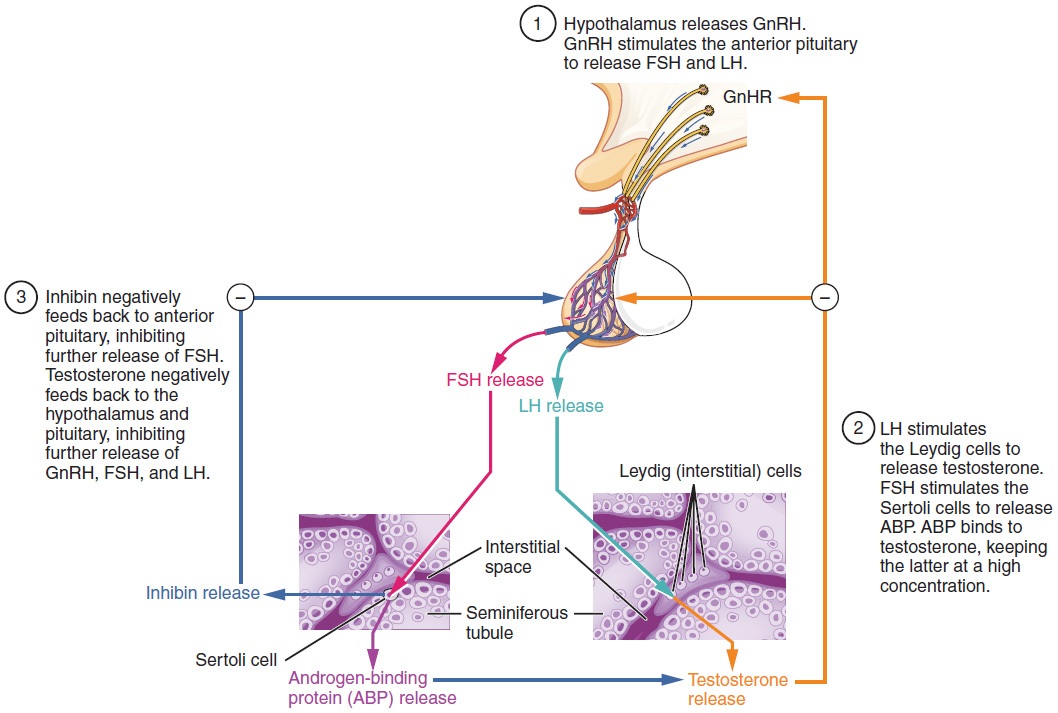 File:Figure 28 01 07.JPG by Wikimedia Commons is licensed under CC BY 3.0
File:Figure 28 01 07.JPG by Wikimedia Commons is licensed under CC BY 3.0
Role of Testosterone
Testosterone plays a very important role in many different ways throughout a male’s life. For instance, it helps with the development of male reproductive organs before birth, contributes to men’s voices getting deeper and the presence of facial hair and acne during puberty, it gives muscles their size and strength, and it helps with a male’s libido, or sex drive (Harvard Health Publishing Harvard Medical School, 2019). When a male has too much testosterone, it can lead to many problems. Some of these problems include low sperm count and smaller testicles, increased risk of heart attacks, liver disease, acne, weight gain, high blood pressure, and high cholesterol (Harvard Health Publishing Harvard Medical School, 2019). Not having enough testosterone leads to its own health problems which can include less hair, loss of bone density and muscle mass, low sex drive, and a low sperm count (Harvard Health Publishing Harvard Medical School, 2019). Reproductive organ problems, along with genetic diseases such as Klinefelter syndrome and hemochromatosis can cause issues with testosterone levels in a male’s body (Harvard Health Publishing Harvard Medical School, 2019).
Role of Estrogen
Interestingly enough, estrogen plays a pretty important role in the male body. Estrogen works along with testosterone to help manage sex drive, erectile function, and sperm production (Jewell, 2019). Just like with testosterone, when a male has too much or too little estrogen, health problems can occur. If a male has too much estrogen, they can experience infertility, erectile dysfunction, slow growth during puberty, an increase in breast fat tissue, and reduced sperm count. If a male does not have enough estrogen not many side effects occur; however, have hormone levels tested regularly in case men need to get treated to get it under control (Jewell, 2019). As men age, their testosterone levels decrease, but their estrogen levels actually increase (Jewell, 2019).
Effects on Behavior
Testosterone has been found to have an effect on behavior throughout a male’s life. It has become apparent that exposure to male-related hormones before birth has an effect on a male’s gender identity and gender-based interests when they are a child (Gray et al., 2017). Before puberty is reached, these hormones play a role in helping males learn skills that will prepare them for future competition with other males (Gray et al., 2017). High levels of testosterone can lead to feelings of anger and aggression. There is evidence that testosterone levels are higher in people who commonly display excessive aggression, such as prisoners whose crimes were violent (Batrinos, 2012).
Testosterone Therapy
The purpose of testosterone therapy is to improve a male’s quality of life or health if his testosterone levels are too low. Despite this, testosterone therapy is a very controversial subject. Therapy benefits may include improvement in energy, sex drive, muscle mass, insulin resistance, and bone mineral density (Khera, 2016). However, short-term side effects could be acne, sleep apnea, swelling or tenderness in the breasts, and swelling in the ankles, although these effects are not extremely common. In the long-term, men who use testosterone therapy have an increased risk of developing cardiovascular issues, and some doctors worry that therapy can stimulate oncogenes for prostate cancer specifically (Harvard Health Publishing Harvard Medical School, 2020).
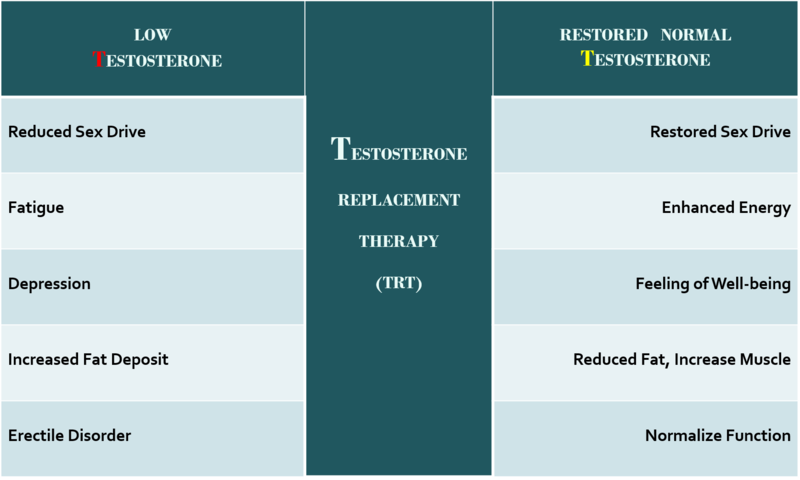
File: Symptoms of Low-T & and TRT to restore.png by Wikimedia Commons is licensed under CC BY-SA 4.0
When to Seek Help
If a male begins to notice acne or weight gain, they may be producing too much testosterone. If hair loss, loss of muscle mass, and reduced sex drive begin occurring, too little testosterone is being produced. Lastly, if a male notices an increase in breast tissue, erectile dysfunction, or that they are growing too slowly, they are producing too much estrogen. All of these are signs of an imbalance in the hormones and should be checked out by a doctor to prevent any long-term damage.
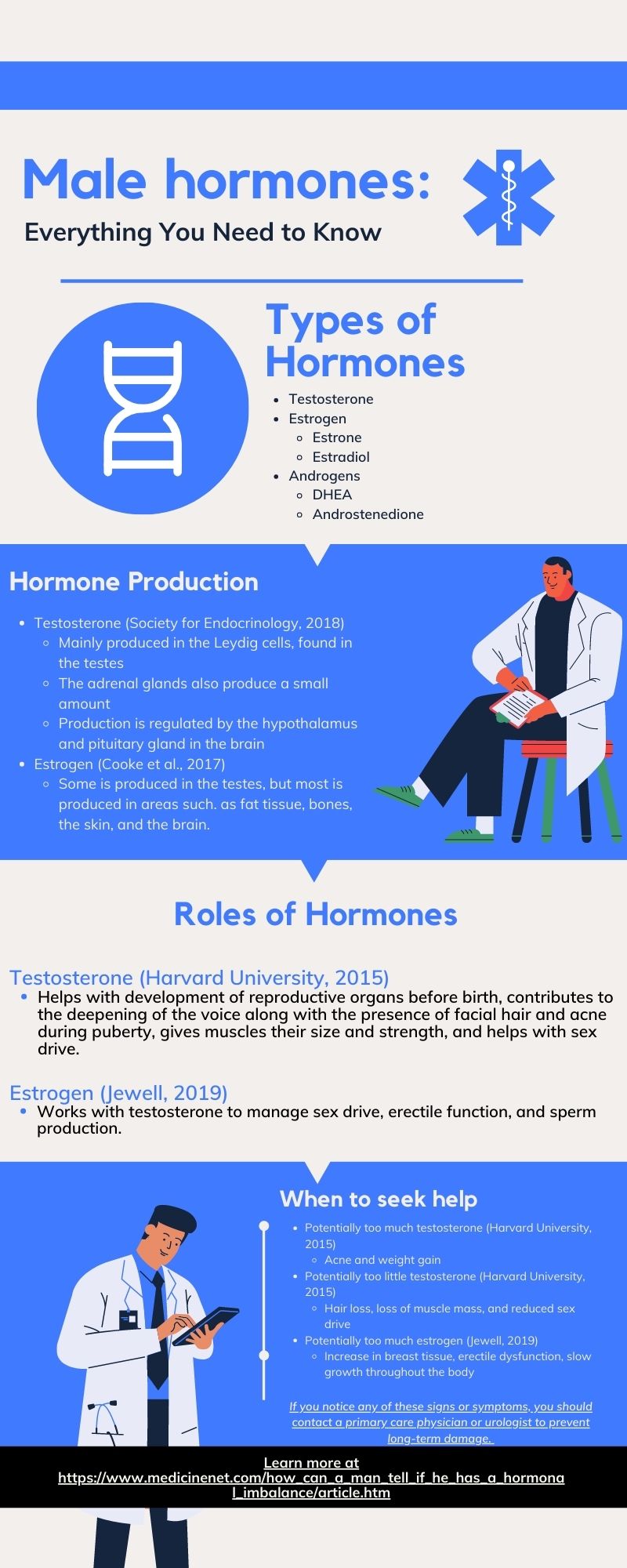
Chapter Review Questions
1. What role does testosterone play before a male is born?
A. Produces body hair
B. Develops the reproductive organs
C. Gives muscles size and strength
D. Contributes to the deepening of the voice
2. Where is the majority of a male's testosterone produced?
A. Adrenal glands
B. The penis
C. Leydig cells
D. Adrenal gland
3. What percent of a male's total estrogen do the testes produce?
A. 20%
B. 25%
C. 50%
D. 80%
References
Batrinos, M. L., (2012). Testosterone and aggressive behavior in man. International Journal of Endocrinology and Metabolism, 10(3), 563-568. 10.5812/ijem.3661
Cooke, P. S., Nanjappa, M. K., Ko, C., Prins, G. S., & Hess, R. A. (2017). Estrogens in male physiology. Physiological Reviews, 97(3), 995-1043. 10.1152/physrev.00018.2016
Gray, P. B., McHale, T. S., & Carré, J. M. (2017). A review of human male field studies of hormones and behavioral reproductive effort. Hormones and Behavior, 91, 52-67. 10.1016/j.yhbeh.2016.07.004
Harvard Health Publishing Harvard Medical School. (2020, August 19). Is testosterone therapy safe? Take a breath before you take the plunge. https://www.health.harvard.edu/mens-health/is-testosterone-therapy-safe-take-a-breath-before-you-take-the-plunge
Harvard Health Publishing Harvard Medical School (2019, August 29). Testosterone-What it does and doesn’t do. https://www.health.harvard.edu/drugs-and-medications/testosterone--what-it-does-and-doesnt-do
Jewell, T., (2019, October 22). Risk factors of having high or low estrogen levels in males. Healthline. https://www.healthline.com/health/estrogen-in-men
Khera, M., (2016). Male hormones and men’s quality of life. Current Opinion in Urology, 26(2), 152-157. 10.1097/MOU.0000000000000256.
Lopez, D., Peskoe, S., Joshu, C., Dobs, A., Feinleib, M., Kanarek, N., Nelson, W., Selvin, E., Rohrmann, S., & Platz, E. (2013). Racial/ethnic differences in serum sex steroid hormone concentrations in US adolescent males. Cancer Causes & Control, 24 (4) 817–826. 10.1007/s10552-013-0154-8
Society for Endocrinology. (2018, February). Testosterone. You and your hormones. https://www.yourhormones.info/hormones/testosterone/
Introduction
Male hair loss affects 50 million men in the United States and about half of all men by 50 (MacGill, 2017). Hair loss affects women as well but is seen more in men. As men get older, their hormone levels change and genes are triggered to contribute to hair loss. With the proper knowledge of the hair loss factors, psychological effects, and treatment methods, men can deal with it
Causes and Signs of Hair Loss
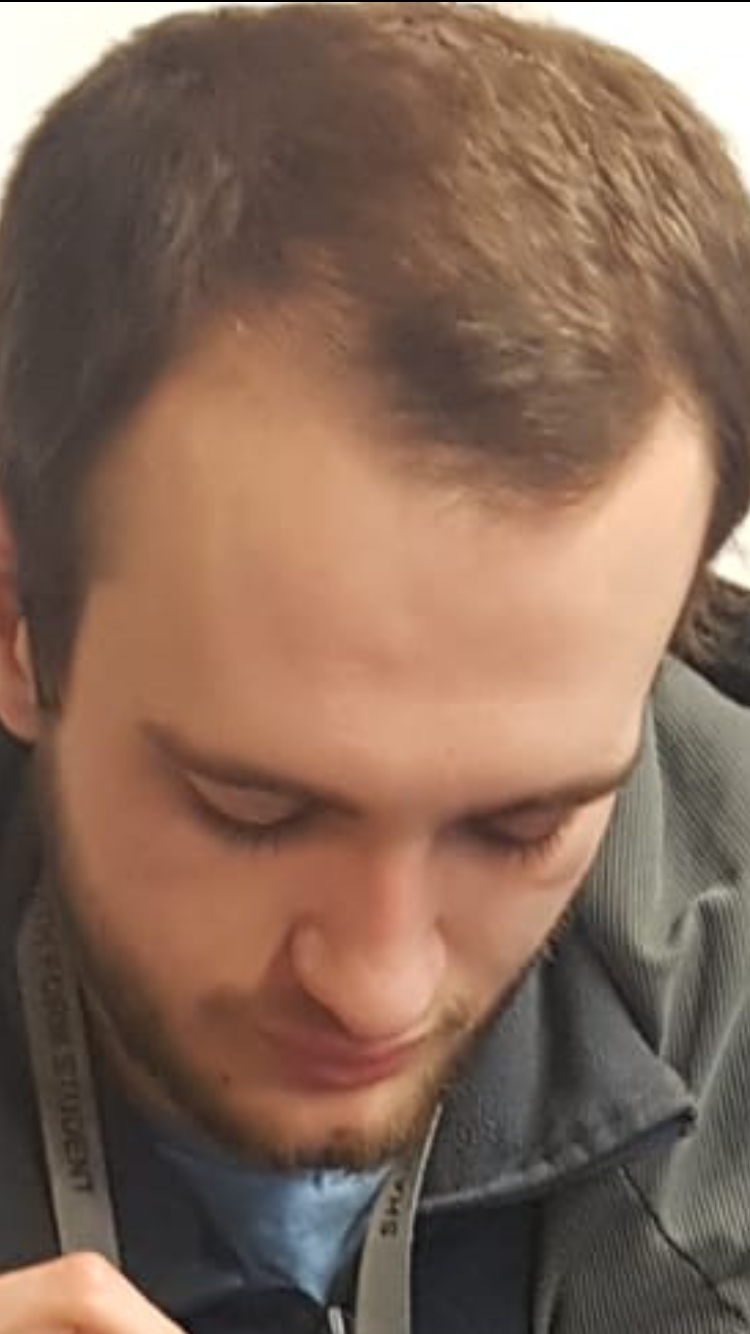
Some signs of male hair loss include excessive shedding and receding hairline. At the temple, the hair starts to thin as well as occurs at the top and the back of the head. One of the most common types of thinning in regards to hair loss is the receding hairline. A receding hairline is when the hair starts to thin and move towards the back of the head. A receding hairline is noticeable because the hairline begins to make an M shape. Hair loss at the top of the head, also known as the crown, gradually happens over time. One will notice that the hair is starting to thin out at the crown until it eventually turns bald (Jewell, 2020).
Androgenetic alopecia is the “most common types of hair loss in men" that causes the symptoms previously stated and is a hereditary condition triggered by genes from parents, a change in hormone levels, and age (Hoffmann, 2002). It is found that "androgenetic alopecia may affect up to 70% of men and 40% of women, generally at some point in their lifetime” (McElwee & Shapiro, 2012). It is a genetically influenced hair loss that causes a gradual change of the terminal hair into vellus hair , it is also characterized with increased shedding (Rathnayake & Sinclair, 2010).
Psychological Effects
Hair loss has a psychological effect on men because they find themselves less attractive and older looking. Many men see hair loss as a sign that their youth is over, and they no longer have control over their physical appearance. Hair loss can lead to a failed relationship because of a decrease in men's self-esteem and attractiveness. There have even been studies that have shown women to find men that are going through hair loss less attractive. When hair loss becomes more recognizable, it can lead to social avoidance instances; meaning, men will avoid being seen in public because of hair loss, which can lead to depression (Hall, 2019). Male hair loss has been linked with "lowered self-esteem and decreased confidence”, which also leads to stress and anxiety (Manning, 2020).
Can Male Hair Loss Be Prevented?
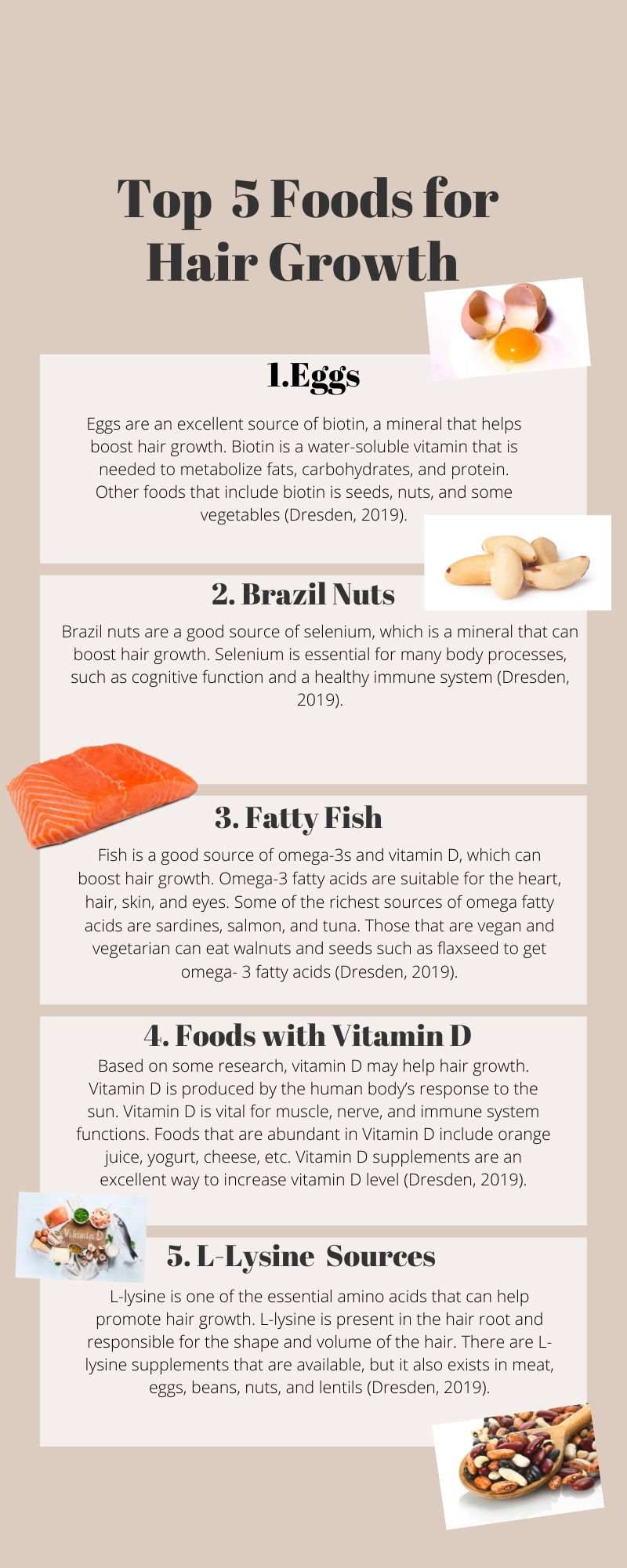
Although androgenetic alopecia is not preventable because it is caused by genes, hormone level changes, and age, there are a few ways to slow hair loss progression. Men can slow hair loss progression and even increase hair growth is by eating a balanced diet. Some foods to incorporate into one’s diet should contain lean protein. Lean proteins, which support hair growth, include fish, lean meats, and soy. Nuts, such as walnuts and cashews, contain various nutrients (i.e. vitamin E, B vitamins, and zinc) that promote hair growth (Raman, 2018). Another way men can slow hair loss is to manage stress by practicing deep breathing techniques, engaging in physical activity, and talking to friends, family, doctors, or therapists about the problems causing stress (Ratini, 2019).
Treatment Options
Medications
Topical Minoxidil was once used to treat high blood pressure in the 1960s but was later discovered to promote hair growth. The FDA approved topical Minoxidil to treat male androgenetic alopecia in 1984 (Rathnayake & Sinclair, 2010). Finasteride is a medication that is also used to treat male pattern hair loss. This medication decreases the amount of dihydrotestosterone (DHT). DHT is a hormone produced by the body that contributes to the development of male characteristics and can cause baldness (Rathnayake & Sinclair, 2010).
Procedures
Another treatment method includes hair transplantation, one of the most rapidly evolving cosmetic surgery (Khanna, 2008). In 1995 follicular unit transplantation was introduced, by which hair can be transplanted in small units. In follicular unit transplantation, the hair can be implanted in two ways: strip harvesting and follicular unit extraction. Strip harvesting is when a strip of the occipital scalp is removed, and the donor's hair is separated into units and transplanted into the balding areas. Follicular unit extraction is when individual follicles of occipital hair are removed, and then each unit is reinserted into the bald area with a microblade. This technique is better than strip harvesting because it leaves no visible scars and takes less time to heal (Rathnayake & Sinclair, 2010). Many surgeons report that follicular unit extraction has a success rate of “more than 90 percent” (Khorsandi, 2020).
Conclusion
Overall, male hair loss is an ongoing issue in males and has many contributing factors such as age, hormones, and genetics. Androgenetic alopecia is the most common type of hair loss triggered by genetics, age, and hormones. Even though androgenetic alopecia can not be prevented, hair loss progression can be slowed by eating a balanced diet as well as reducing stress. Treatment for hair loss has evolved, because of new discoveries in medicine, and cosmetic surgical procedures.
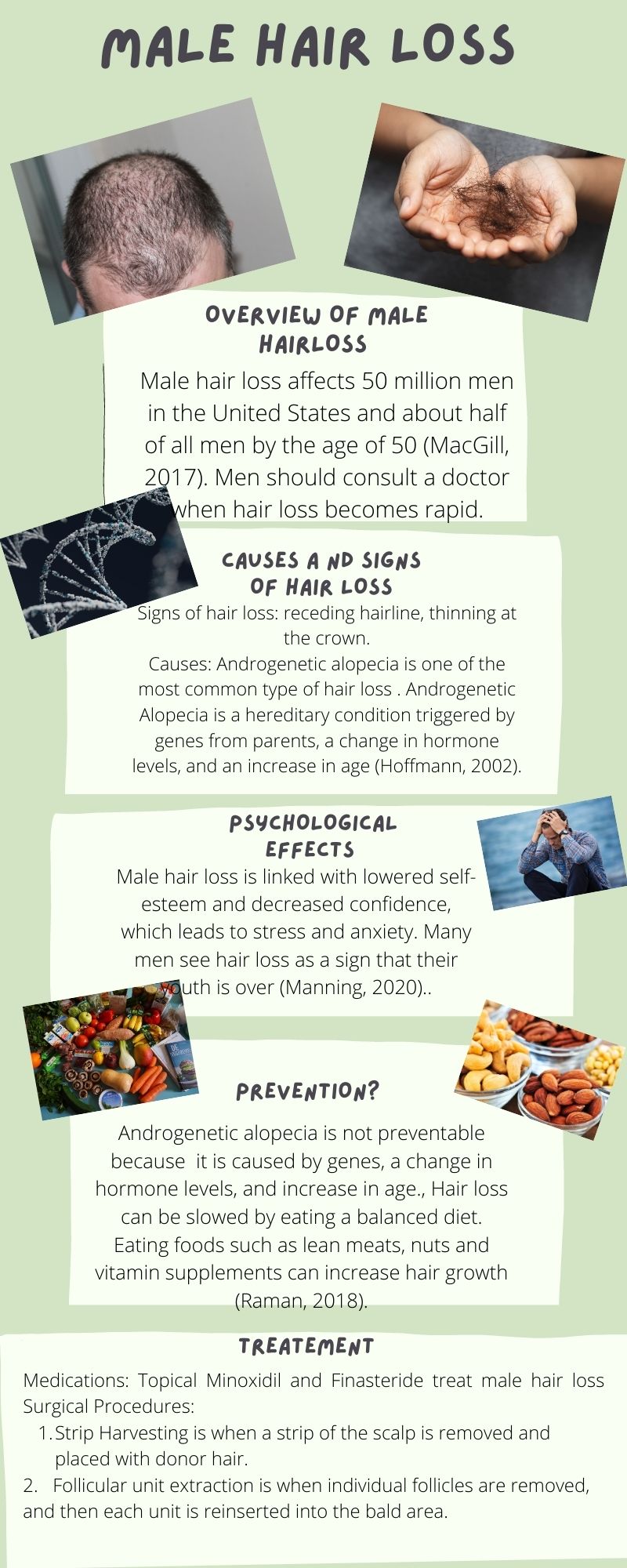
Chapter Review Questions
1. The most common type of hair loss in men is?
A. The receding hairline
B. Androgenetic alopecia
C. Hair loss at the crown
D. Hair loss at the temple
2. Which of the following is not triggered by androgenetic alopecia?
A. Genes
B. Stress
C. Hormones
D. Age
3. Finasteride is a medication that ______ the amount of dihydrotestosterone
A. Increases
B. Decreases
C. Maintains
D. Eliminates
References
Dresden, D. (2019, April 12). What are the best foods for healthy hair growth? Medical News Today. https://www.medicalnewstoday.com/articles/324949.
Hall, K. (2019, June 07). The psychological impact of male hair loss. Hims. https://www.forhims.com/blog/the-psychological-impact-of-male-hair-loss
Hoffmann, R. (2002). Male androgenetic alopecia. Clinical and Experimental Dermatology, 27(5),373-382. https://doi.org/10.1046/j.1365-2230.2002.01086.x
Jewell, T. (2020, January 6). Early signs of balding in men and women. Healthline. https://www.healthline.com/health/beauty-skin-care/signs-of-balding.
Khanna, M. (2008). Hair transplantation surgery. Indian Journal of Plastic Surgery: Official Publication of the Association of Plastic Surgeons of India, 41(Suppl), S56-S63. https://www.ncbi.nlm.nih.gov/pmc/articles/PMC2825128/
Khorsandi, D. C. (2020, January 21). What's the success rate of FUE hair restoration? Plastic Surgery Las Vegas, NV. https://vipplasticsurgery.com/blogs/whats-the-success-rate-of-fue-hair-restoration#:~:text=Most%20reputable%20surgeons%20report%20FUE,thinning%20hair%20or%20hair%20loss.
MacGill, M. (2017, July 28). Male pattern baldness: Causes and treatment. Medical news today. https://www.medicalnewstoday.com/articles/68077#causes.
Manning, M. (2020, November 18). How hair loss in men affects self-esteem. WebMD. https://www.webmd.com/connect-to-care/hair-loss/how-hair-loss-in-men-affects-self-esteem.
McElwee, K., & Shapiro, J. (2012). Promising therapies for treating and/or preventing androgenic alopecia. Skin Therapy Letter, 17(6), 1-4. https://www.researchgate.net/publication/228070384_Promising_therapies_for_treating_andor_preventing_androgenic_alopecia
Raman, R. (2018, April 9). The 14 best foods for hair growth. Healthline. https://www.healthline.com/nutrition/foods-for-hair-growth
Rathnayake, D., & Sinclair, R. (2010). Male androgenetic alopecia. Expert Opinion on Pharmacotherapy, 11(8), 1295-1304. 10.1517/14656561003752730
Ratini, M. (2019, April 25). 10 tips to manage stress. WebMD. https://www.webmd.com/balance/guide/tips-to-control-stress

